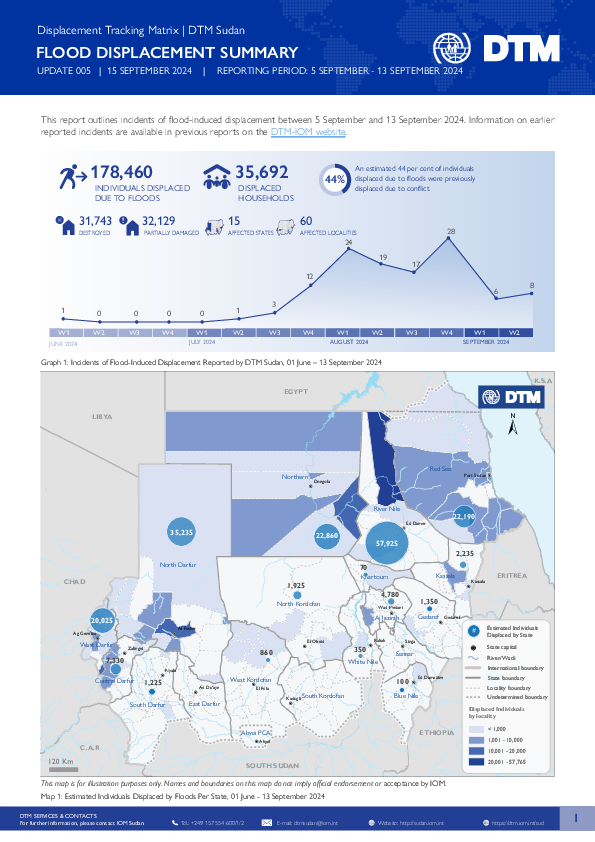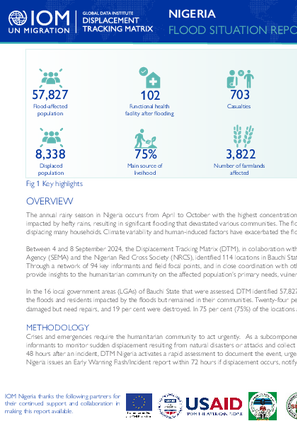-
Countries
-
Data and Analysis
-
Special Focus
-
Crisis Responses
Situation Report

Contact
DTM Nigeria, iomnigeriadtm@iom.int
Language
English
Location
Nigeria
Period Covered
Sep 04 2024
Sep 08 2024
Activity
- Mobility Tracking
- Event Tracking
Between 4 and 8 September 2024, the Displacement Tracking Matrix (DTM), in collaboration with the National Emergency Management Agency (NEMA), the Sokoto State Emergency Management Agency (SSEMA), and the Nigerian Red Cross Society (NRCS), identified 53 locations in Sokoto State that were impacted by floods or received internally displaced persons (IDPs) due to the flooding.
In the 10 local government areas (LGAs) of Sokoto State that were assessed, DTM identified 56,308 individuals in 10,808 households affected by the floods. These individuals included IDPs who were displaced by the floods and residents who were impacted by the floods but remained in their communities. The affected population included 14,994 displaced individuals.
Forty-three per cent (43%) of the affected houses were habitable but need repair, thirty-one per cent were partially damaged, and 26 per cent were totally destroyed. In 60 per cent (60%) of the locations assessed, crop farming was among the primary sources of income.

Contact
DTM Nigeria, iomnigeriadtm@iom.int
Language
English
Location
Nigeria
Period Covered
Sep 04 2024
Sep 09 2024
Activity
- Mobility Tracking
- Event Tracking
Between 4 and 8 September 2024, the Displacement Tracking Matrix (DTM), in collaboration with the National Emergency Management Agency (NEMA), the Zamfara State Emergency Management Agency (ZSEMA), and the Nigerian Red Cross Society (NRCS) identified 51 locations in Zamfara State that were impacted by floods or received internally displaced persons (IDPs) due to the flooding.
In the eleven (11) local government areas (LGAs) of Zamfara State that were assessed, DTM identified 70,819 individuals in 13,965 households affected by the floods. These individuals included IDPs displaced by the floods and residents impacted by the floods but remained in their communities. The affected population included 17,623 displaced individuals and 1,238 returnees. forty-nine per cent (49%) of the affected houses are habitable but need repair, twenty-eight per cent of the houses are partially damaged and sixteen per cent are completely destroyed. In 31 per cent (31%) of the locations assessed, crop farming was among the primary sources of income.

Contact
DTM Nigeria, iomnigeriadtm@iom.int
Language
English
Location
Nigeria
Period Covered
Sep 04 2024
Sep 08 2024
Activity
- Mobility Tracking
- Event Tracking
Between 4 and 9 September 2024, the Displacement Tracking Matrix (DTM), in collaboration with the Benue State Emergency Management Agency (BENSEMA), identified 22 locations in Benue State that were impacted by floods.
In the twenty-two (22) local government areas (LGAs) of Benue State that were assessed, DTM identified 7,092 individuals in 1,089 households affected by the floods. The floods displaced many residents, while some remained in their affected communities. All the affected population were residents. Twenty-three per cent (23%) of the affected houses are habitable but need repair, 13 per cent of the houses are partially damaged and two per cent of the houses are totally destroyed. In 45 per cent (45%) of the locations assessed, crop farming was among the primary sources of income.

Contact
DTM Nigeria, iomnigeriadtm@iom.int
Language
English
Location
Nigeria
Period Covered
Sep 04 2024
Sep 08 2024
Activity
- Mobility Tracking
- Event Tracking
Between 4 and 8 September 2024, the Displacement Tracking Matrix (DTM), in collaboration with the National Emergency Management Agency (NEMA), the Katsina State Emergency Management Agency (SEMA), and the Nigerian Red Cross Society (NRCS), identified 234 locations in Katsina State that were impacted by floods or received internally displaced persons (IDPs) due to the flooding.
In the seventeen (17) local government areas (LGAs) of Katsina State that were assessed, DTM identified 123,377 individuals in 16,563 households affected by the floods. These individuals included IDPs displaced by the floods and residents impacted by the floods but remained in their communities. The affected population included 12,927 displaced individuals and 473 returnees.
Thirty-two per cent (32%) of the affected houses are habitable but need repair, 17 per cent are partially damaged and 10 per cent are totally destroyed. In 70 per cent (70%) of the locations assessed, crop farming was among the primary sources of income.

Contact
DTM Yemen, iomyemendtm@iom.int
Language
English
Location
Yemen
Period Covered
Sep 08 2024
Sep 14 2024
Activity
- Mobility Tracking
- Event Tracking
IOM Yemen DTM’s Rapid Displacement Tracking (RDT) tool collects data on estimated numbers of households forced to flee on a daily basis from their locations of origin or displacement, allowing for regular reporting of new displacements in terms of estimated numbers, geography, and needs. It also tracks returnees who returned to their location of origin.
From 1 January to 14 September 2024, IOM Yemen DTM tracked 2,633 households (HH) (15,798 Individuals) who experienced displacement at least once.
Between 8 and 14 September 2024, IOM Yemen DTM tracked 86 households (516 individuals) displaced at least once. The majority of people moved into/within the following governorates and districts:
- Lahj (59 HHs) – Al Musaymir (59 HHs) district. All displacements in the governorate were internal.
- Ma’rib (14 HHs) – Ma’rib City (8 HHs), Ma’rib (6 HHs) districts. Most displacements in the governorate originated from Al Hodeidah and Al Mahwit.
- Ta’iz (7 HHs) – Al Maafer (5 HHs), Al Misrakh (2 HHs) districts.. Most displacements in the governorate originated from Ta’iz and Al Hodeidah.
The majority of people moved from the following governorates and districts:
- Lahj (63 HHs) – Al Musaymir (63 HHs) district.
- Al Hodeidah (7 HHs) – Ad Dohi (2 HHs), Al Qanawis (2 HHs), Al Hali (1 HH) districts.
- Ta’iz (7 HHs) – Maqbanah (5 HHs), Mawiyah (1 HH), Al Qahirah (1 HH) districts.
IOM identified 186 additional households displaced in the previous reporting period, which covered 01 - 07 September 2024, in the governorates of Lahj (168 HHs), Al Hodeidah (9 HHs), Ma’rib (7 HHs), and Ta’iz (2 HHs). These figures have been added to the cumulative displacement total recorded since the beginning of the year.

Contact
DTM Sudan; dtmsudan@iom.int
Language
English
Location
Sudan
Period Covered
Sep 05 2024
Sep 13 2024
Activity
- Mobility Tracking
- Event Tracking
The Flood Displacement Summary summarizes DTM updates on incidents of flood-induced displacement across Sudan.
Between 01 June and 13 September 2024, DTM Sudan reported 119 incidents of heavy rain and floods that triggered sudden displacement in Sudan. Rain and floods displaced an estimated 178,460 individuals (35,692 households) from locations across 15 different states in Sudan.
This report outlines incidents of flood-induced displacement between 05 September and 13 September 2024. Further information on earlier reported incidents is available on the DTM-IOM Sudan website.
Highlights
- DTM observed eight incidents of flood-induced displacement between 05 September and 13 September 2024.
- These reported incidents triggered the displacement of an estimated 5,940 individuals (1,188 households).
- Approximately 1,349 structures were either destroyed or partially damaged due to rain or floods.
- An estimated 44 per cent of individuals displaced due to floods were already displaced due to conflict prior to the onset of floods.

Contact
DTM Nigeria, iomnigeriadtm@iom.int
Language
English
Location
Nigeria
Period Covered
Sep 04 2024
Sep 09 2024
Activity
- Mobility Tracking
- Event Tracking
Between 4 and 9 September 2024, the Displacement Tracking Matrix (DTM), in collaboration with the National Emergency Management Agency (NEMA), the Gombe State Emergency Management Agency (GOSEMA), and the Nigerian Red Cross Society (NRCS), identified 42 locations in Gombe State that were impacted by floods or received internally displaced persons (IDPs) due to the flooding.
In the eight (8) local government areas (LGAs) of Gombe State that were assessed, DTM identified 14,910 individuals in 1,741 households affected by the floods. The floods displaced IDPs and residents impacted remained in their communities. The affected population included 2,994 individuals and 339 IDPs. Thirty-eight per cent (38%) of the affected houses are habitable but need repair, twenty per cent of the houses are partially damaged but need repairs and 22 per cent of the houses are destroyed. In 93 per cent (93%) of the locations assessed, crop farming was among the primary sources of income.

Contact
DTM Nigeria, iomnigeriadtm@iom.int
Language
English
Location
Nigeria
Period Covered
Sep 03 2024
Sep 09 2024
Activity
- Mobility Tracking
- Event Tracking
Between 3 and 9 September 2024, the IOM Displacement Tracking Matrix (DTM), in collaboration with the National Emergency Management Agency (NEMA), the Adamawa State Emergency Management Agency (ADSEMA), and the Nigerian Red Cross Society (NRCS), identified 38 locations in Adamawa State that were impacted by floods or received internally displaced persons (IDPs) due to the flooding.
In the nine (9) LGAs of Adamawa State that were assessed, DTM identified 24,169 individuals in 4,373 households affected by the floods. These individuals included IDPs who were displaced by the floods and residents who were impacted by the floods but remained in their communities. The affected population included 7,074 individuals and 3,120 returnees. Twenty-two per cent (22%) of the affected houses are habitable but need repair, thirty-one per cent (31%) of the houses are partially damaged but need repairs, and 18 per cent (18%) of the houses are destroyed. In eighty-two per cent (82%) of the locations assessed, crop and vegetable farming were among the primary sources of income.

Contact
DTM Nigeria, iomnigeriadtm@iom.int
Language
English
Location
Nigeria
Period Covered
Sep 04 2024
Sep 08 2024
Activity
- Mobility Tracking
- Event Tracking
Between 4 and 8 September 2024, the Displacement Tracking Matrix (DTM), in collaboration with the National Emergency Management Agency (NEMA), the Taraba State Emergency Management Agency (TSEMA), and the Nigerian Red Cross Society (NRCS), identified 56 locations in Taraba State that were impacted by floods or received internally displaced persons (IDPs) due to the flooding.
In the seven (7) Local Government Areas (LGAs) of Taraba State that were assessed, DTM identified 32,319 individuals in 7,349 households affected by the floods. These individuals included IDPs displaced by the floods and residents impacted by the floods but remained in their communities. The affected population included 1,741 displaced individuals and 232 returnees. Twenty per cent (20%) of the affected houses are habitable but need repair, 12 per cent are partially damaged and need repairs, and nine per cent are completely destroyed. In 77 per cent of the locations assessed, crop farming was among the primary sources of income.

Contact
DTM Nigeria, iomnigeriadtm@iom.int
Language
English
Location
Nigeria
Period Covered
Sep 04 2024
Sep 08 2024
Activity
- Mobility Tracking
- Event Tracking
Between 4 and 8 September 2024, the Displacement Tracking Matrix (DTM), in collaboration with the National Emergency Management Agency (NEMA), the Bauchi State Emergency Management Agency (SEMA) and the Nigerian Red Cross Society (NRCS), identified 114 locations in Bauchi State that were impacted by floods or received internally displaced persons (IDPs) due to the flooding.
In the 16 local government areas (LGAs) of Bauchi State that were assessed, DTM identified 57,827 individuals in 9,620 households affected by the floods. These individuals included IDPs displaced by the floods and residents impacted by the floods but remained in their communities. Twenty-four per cent (24%) of the affected houses are habitable but need repair, repairs, 18 per cent were partially damaged but need repairs, and 19 per cent were destroyed. In 75 per cent (75%) of the locations assessed, crop farming was among the primary sources of income.
Pagination
- Previous page
- Page 11
- Next page
